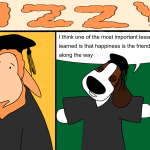Generally speaking, the easiest way to save money is to reduce expenditure. College of William and Mary Provost Michael R. Halleran took a different approach when he outlined the Creative Adaption Fund in a memo to faculty earlier this month.
Rather than cut programs, this fund entices professors to think of ways to save money in the long run. Based on the applications, funding will be given to the best ideas. In essence, Halleran is creating projects to save money.
I’m not a professor, but I would love to have funding for some ideas brewing in my head. Maybe the provost will read this and create an exception. Students have a say, too, and I think many students would agree that these ideas would be beneficial across the board.
Idea number one: Create a campus-wide fantasy football league. Charge two dollar admission. It can be organized by social class. There’s really no downside, and I’m sure it’d give the tech department something fun to work on. I can see it now — body painters on the terrace, TWAMPs reveling in their newest projections.
Winners receive priority registration. The fantasy league actually saves money — instead of trying to register through the joys of Banner, teams can just register through the league’s site.
Just in case the provost isn’t into fantasy football, here’s the second idea: Friday night blackouts.
Not actually a blackout, but a push for everyone who doesn’t need to use electricity to turn it off. Like on Earth Day, when people around the globe voluntarily turn off all electrical appliances for an hour, the College will be dark for an hour.
Again, not many downsides since this project is entirely voluntary. On the other hand, there are a few upsides. One, blackouts give parties a whole new twist. Two, blackouts help the environment and save money on the College’s massive electrical bill. Three, who doesn’t love a good game of hide and seek?
A couple of other ideas: No shower Mondays, not using leaf-blowers every single day, printing The Flat Hat on recycled paper and bringing out vintage uniforms for sports teams rather than buying new ones each season.
With limited and unreliable funding from the state, the College is right to look for ways to save money. In fact, the College has already shown a remarkable ability to operate efficiently on reduced amounts of revenue.
With the onset of the Creative Adaption Fund, the College is taking steps in the right direction. While currently only available to faculty and staff, I encourage the Provost and others to consider the idea of a similar fund for students.
I promise, they won’t all be like the fantasy football idea.


































